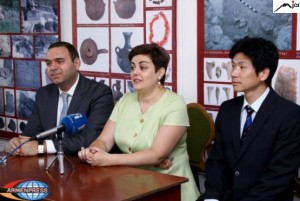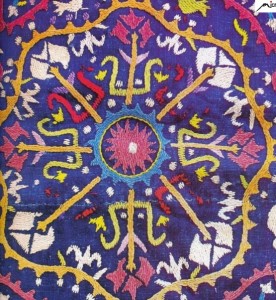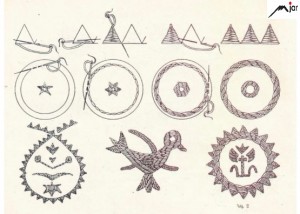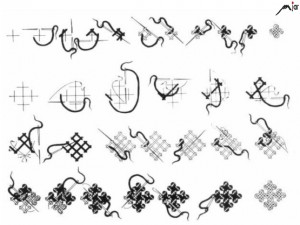日本人女性の目を通したアルメニアのマラッシュ刺繍
04.18 · 2020
“It is necessary for the Japanese to realize that there are many things to learn from the secrets of the Armenian embroidery”.
It’s a great pleasure when people are interested in Armenia, in the historical-cultural heritage of the Armenian nation, when they value it. This time I introduce to you a friend of the Armenian nation Mrs. Mie Ishi, who is considered one of the best specialists of fabric restoration in the world. She has visited Armenia for many times and has summed up her impressions in different scientific articles. The last of these articles has especially attracted my attention. Thus…
From 2011 to 2014 in the History Museum of Armenia for the specialists of the museums MIE ISHI has conducted fabric restoration and maintenance seminars, which were organized by the Japan Foundation.
Fabric restoration courses will give new skills to the Armenian specialists
YEREVAN, September 11, ARMENPRESS: The specialists of Tokyo National Research Institute will introduce to the Armenian restorers and archaeologists the new methods and ways of fabric restoration.…
In 2015 in the frameworks of art and craft promotion research grant project of Sato foundation in the museums of Echmiadzin Cathedral she studied the religious attire. In 2017 as a lecturer she participated in fabric restoration and maintenance seminars conducted in the scientific-research center of historical-cultural heritage. The seminars were held by the Ministry of Culture of RA and the International Cooperation Center in the sphere of Cultural Heritage of Tokyo Cultural Value National Research Institute.
MIE ISHI writes that due to this event as a foreigner she had an opportunity to closely get acquainted with the Armenian fabric. When she is asked what the Armenian fabric is, she answers: “It is the Armenian soul embraced in the thread”. According to her the restoration and maintenance of cultural heritage is not only a way of physical preservation of an object but a person should have such an approach, which is necessary also for preservation of the invisible and intangible factors embraced in the object – the soul and the faith.
During the seminars conducted in the frameworks of the international cooperation, the author was primarily interested in what is important for the Armenians. She started to study the Armenian embroidery because in the embroidery as well as in the restoration of the fabric, there is used a thread and a needle, which were familiar to her and because she felt that the world of needles and threads can overcome the language barrier. Every time visiting Armenia little by little she studied embroidery.
In her works the author presents the general outline of the Armenian embroidery which is still unknown in Japan, discusses “Marash embroidery” inherited by the Republic of Armenia today. At the end she presents the teaching of art including the teaching of embroidery. She also discusses issues concerning the continuity of traditional fabric technology, which is a problem in Japan.
Armenian embroidery։ In the center of the capital Yerevan, in Republic Square, there is located History Museum of Armenia. On the first floor of the museum there is the exhibition of carpets and on the second floor there is the permanent exhibition of national clothes. In one of the halls of the second floor the mannequins are dressed in the national clothes of the 19th century up to the beginning of the 20th century. In another hall you can see embroidered works of different types and made with different techniques (as of September 2017). From the History Museum it becomes clear that in Armenia they highlight carpets, national clothes and embroidery. In order to get acquainted with the fabric of modern Armenia one can visit Vernisage Park in the neighborhood of Republic Square.
At Vernisage Market there are presented interesting samples. The embroidered ornaments are traditional – pomegranates, miniature paintings taken from the Bible and so on. You can also see works, which are diligently done. From the stories of selling women (embroiderers) you get to know that there are masters, who were received by the Government of Armenia and who were winners of Russia applied arts competitions. Thus, it was interesting to walk around and to see the difference of styles and techniques.
Embroidery is a traditional skill, which Armenian women have inherited. They also sell their embroidery at the market as a means of income. When I asked about the embroidery they showed different embroideries and said: “This is a lace of Ayntap, Marash, Van”. I looked up the words in the dictionaries and realized that they are names of places. Ayntap is a town in the south-east of Turkey: the peculiarity of this embroidery is the technique called “drawwork” on a white cloth. Marash is also a town in the south-east of Turkey. With the main colors of red and black, as if weaving a rope on the velvet they embroider a cross. Van is a town in the East of Turkey and the lace is mesh embroidered fabric with needle and thread (it has the same technique as the Turkish oyan).
There is little English literature about the Armenian embroidery and by means of on-site works I finally realized that there isn’t any embroidery, which we can say in one word “Armenian embroidery”. The names of the Armenian embroidery origin from the names of places and the term “Armenian embroidery” is a common name for various ornaments and techniques. Calling the embroidery by the names of places is deeply connected with the history of Armenia. As a sign of belonging to a certain community, women used unique types of embroidery and by means of needle and thread expressed the difference from other communities.
In the Middle Ages the territory of Armenia expanded (Cilician Armenia, 1080, 1198, 1375), but in 1636 it was divided between the Ottoman Empire and the Sefyan Persia. Outside the Christian Armenians were subject to the religion of the rulers (for example, the Armenian women don’t wear headscarves but when going out they wore them). In the family and inside the community they preserved the national identity, which has been united with the religion. In 1826 after the second Russian-Persian war, the part of Armenia which was in the staff of Persia became part of Russia.
In the Ottoman Empire the ethnical conflicts between the Armenians and the Turkish escalated and in 1915–1916 took place a tragedy – the Armenian Genocide. The Armenians who survived after the Genocide emigrated to Armenia, which was part of Russia (the Republic of Armenia nowadays), Syria, Lebanon, France, Italy, the United States. Beyond Armenia there is a big community of Armenians, which is called diaspora (from Latin it means spreading, expansion). In the country the charity organizations taught embroidery to the orphans and widows for the purpose of gaining independence.
Nowadays in the Republic of Armenia besides the lace of Van, one can see the embroideries of Marash and Ayntap mentioned above. In the capital of Lebanon Beirut, the Armenian community gathered the embroidery inherited in all the regions and published a book titled “Marash Embroidery” (Tokmajian, 2010). The Armenians realize that in order to inherit the Armenian embroidery, which has the peculiarities of the region, to the generations far from the motherland, it is necessary to strengthen the national identity.
With deep respect and admiration I should state that it happens very rarely when a Japanese researcher writes in an open context about the Armenian Genocide. Perhaps this fact itself deserves great respect. Anna Vardanyan
The main symbols of embroidery։ In order to understand the Armenian embroidery it is necessary to know the symbols contained there. The widely spread ones are the following:
Eternity (sun cross)
Sun cross is the sign of eternity. It’s the symbol of Armenia, which is also called the Armenian ball. It is often depicted in a circle – eight wings are tilted to the right or to the left. The sun cross originated in the ancient times, you can even go back to the Bronze Era, see them in the areas, where the Armenians inhabited in the past. The number 8 is the sum of 4 directions –East, West, North and South and the four elements (air, fire, water, earth), which symbolizes the world. In Armenia they love number 4 and its double.
Sun (flower)
The eight-winged star or the eight-petal flower symbolizes the God of the sun. The petals of the flower aren’t limited to eight; they can also be the multiple of number four. The sign of the sun can be easily mixed with the sign of eternity.
Tree of life
The tree of life is pomegranate, the symbol of fertility and life. A couple (a man and a woman, people) the symbols of a man or a woman or people express the Armenians, symbolize fertility and life.
“The Armenian soul is embraced in the thread”.
Mie Ishi
Marash embroidery։ Marash is a name of place located in the south-east of today’s Turkey and is called Town of Kahramanmaras. Marash was a town of the Armenian Kingdom of Cilicia and until the Armenian Genocide in 1915–16, it was mostly inhabited by the Armenians. Many Armenians from Marash who survived after the Genocide fled to Lebanon, Aleppo and Damascus towns of Syria, Armenia, which was part of Russia. Marash embroidery witnesses the prosperity of Armenia. It witnesses that Armenians have lived on that land and that today’s Armenia has inherited it.
After the riots that started in Syria in 2011, many Armenians fled to Armenia. Refugee women make goods with Marash embroidery and the benevolent organizations are engaged in the trade activities as well.
The technique of embroidery: In Marash embroidery they use satin-stitch and knitted stitch. Sometimes they embroider with only one type of stitch. There can be works where the two techniques are used. The two techniques (stitches) together are called Marash embroidery. The peculiarity is the knitted stitch. “Marash Embroidery” by Serik Davtyan (1978) is a widespread manual, where the drawings clearly show the ways of sewing. The satin-stitch (Zeytun sewing, irka, atlazlama) is a filling technique, in case of which the cloth is covered with stem sewing. Knitted stitch is a way of wrapping the threads in a crossed way after the laying of the basic thread.
If the crosses are continued, the heringbone stitch can be made in two layers and make a line, circle, triangle, square and other forms. As on the traditional Armenian cross-stones there are also carved ornaments of crossed threads, they are also called embroidered cross-stones. Wherever the Armenian community started to inhabit, you can see stitches with the same technique.
In India they call it Kutch work (in Hindu Gujrati or Shindi), and this has taken root as the Indian embroidery. The stitches of Armenia and India don’t differ by the final appearance of embroidery but by the way of making an outline. In Armenia they make the outline of the cross and put the needle from the tops and in India they don’t draw a cross but the make the ready line. They use thin, tightly twisted cotton or silk threads (DMC embroidery, threads no 5–8).
Though the embroidery thread used in satin-stitch is cotton and slightly twisted, in case of knitted stitch they usually use thin, tightly twisted cotton thread, they also use woolen, silk, metal threads. In order not to pull the threads of the cloth, it is suitable to use a round-tip needle. In order to start the embroidery they choose the sketch and draw it on the cloth.
At the History Museum of Armenia there is exhibited a wooden stamp cross, with which they stamped the cloth. Nowadays the drawing is done with a ruler, pencil or tailor’s chalk pencil. Marash embroidery was used for the wall carpets, bed covers, tablecloths and for other decorations of the room. Looking at the works of the beginning of the 20th century we realize that there were used silk, velvet, thick cotton and linen cloths of red, dark blue, black and other dark colors.
Knitted stitch is called “secret stitch”, which is hard to learn, without the help of the person who is familiar with the “secret”. If you mix the crossing of the fir-form stitch main threads for making the double ornament of the cross, the knitting thread will not enter properly. When actually making Marash embroidery, you draw the sketch of the cross, knit the thread following it and automatically return to the starting point, it seems to you that this action is the merging of Christianity and the eternity of Armenia, which is so characteristic of the Armenian embroidery.
The teaching of embroidery։ In Yerevan there is the first children’s gallery in the world, which was founded in 1970 and is specialized in the gathering, maintenance and exhibition of works of art made by children. In 1968 the founder Henrik Igityan saw children’s exhibition in Yerevan and thought that those works should be maintained and decided to found a gallery that would exhibit children’s art.
In 1978 there was founded National Center of Aesthetics as an organization related to this gallery. Since the Soviet Union times by means of teaching art to the children the center has taken the role of transmitting the national identity. After the classes children can attend the center and learn painting, engraving, embroidery and so on free of charge.
The author of the article visited the school in Yerevan in 2012, the school of Talin in 2013 and was surprised by the fact that despite being National Center of Aesthetics the class was in a secret place in a residential area and had no sign. The children were making works with Marash embroidery, which were not bounded by the tradition and style. They explained that they didn’t use textbooks in the center and that the teaching was taking place from the teacher to the child by means of speech and showing the skills.
Visiting the National Center of Aesthetics it became clear why there were so few manuals of embroidery in Armenian. By means of art they transmit the core of the nation’s identity and the best way of teaching art is the transmission from a man to a man. The nation, which has gone through hardships, inherits the art without any written evidence of the activity. This concerns the embroidery as well.
Embroiderer and leading specialist in the field of teaching embroidery Lusine Mkhitaryan teaches at the National Center of Aesthetics and Teryan Cultural Center envisaged for the adults. Teacher Lusine has taught Marash embroidery to the author of the given article without any manuals, by means of showing the skills. By means of changing the colors of the main and twisting threads teacher Lusine gave Marash embroidery coloring and a design, which corresponds to the modern life. While teaching children she is not stinted by the traditional ornaments and by leaving it on the children’s imagination promotes the artistic expressions and gives fresh breath to Marash embroidery.
Epilogue։The Armenian embroidery is an applied art, which has survived together with its nation that had suffered from hardships. This is the common term for the embroideries of different designs and techniques, which have the name of the region, where they have originated. Far from its primary place of origin, by means of education passing to the generations, the Armenian community inherits the embroideries of all the communities as the Armenian embroidery to the generations adapting to the modern way of life.
Japan attaches importance to the traditional culture however there is no state-funded system for teaching textile applied art from an early age and at present the Japanese embroidery and other arts concerning textile rapidly disappear. However no measures are being taken. It is necessary for the Japanese to realize that their identity is in the Japanese embroidery and Japanese textile as well and concerning this issue there are many things to learn from the “secrets of the Armenian embroidery”.
As a summary, the author of the article expresses gratitude to her friends. The international cooperation in Armenia wouldn’t take place without the help of the Professor of Teiku University Kadzuya Yamauchi and the lecturer Akira Fujisawa, the Associate Professor of Tokai University Arimura Makoto, the lecturer of Saitamai branch of NHK Cultural Center Yokoyama Midori. Her Armenian friends have also assisted her: fabric restorer of the History Museum of Armenia Maro Harutyunyan, interpreter Lilit Khansulyan, interpreter Ruzan Khojikyan and the teacher of embroidery Lusine Mkhitaryan. The given research was conducted by means of the research grant projects of Japan Foundation and Sato Foundation for the promotion of art and craft. Sincere thanks to everyone for the cooperation.
I think that this list of literature will be of great assistance to the masters, people who are interested in the subject in order to continue their research.
1) Mie Ishi, Makoto Arimura, Midori Yokoyama “Report on 2011–2014 Seminar Works on Textile Restoration and Maintenance at the History Museum of Armenia” Japan Foundation
2) Mie Ishi, Midori Yokoyama “Study and Maintenance of Fabric Cultural Values in the Museums of Mother See of Holy Echmiadzin of Armenian Apostolic Church”, Report of Sato Foundation Research Grant Project on Art and Craft Promotion, 17th Report of Teiko University Cultural Heritage Research Institute (March 31, 2018)
3) Tolmajian Hrazdan. Marash Needlework, p.24. Aleppo: Union of Marash Armenians karmaning Vasbouragan Cultural Union. 2010 (English identical translation from Armenian)
4) Armenian Relief Cross of Lebanon: Beirut. 1999 (English identical translation from Armenian)
5) Homeland Development Initiative Foundation, 2/2 Melik Adamyan st. Yerevan +374 77 473335 https://www.hdif.org
6) Thérèse de Dillmont. The Complete DMC Encyclopedia of Needlework. D.M.C. Library (first edition 1890) I have used reprinted work, the year of publication is unknown տպագրությանտարինանհայտէ
7) Serig Davtian. Marash Embroidery, Yerevan 1978 (Armenian, the content is summarized in Russian and English as well)
8) Charles E. Garoian. Teaching Art as a matter of cultural survival: Aesthetic education in the Republic of Armenia. Journal of Aesthetic Education 28(2) pp. 83–94, 1994.
9) National Aesthetic Education Center. Abovyan 13, 0001. Children’s Art Gallery, Abovyan 13, 0001, Yerevan, Tel (+375 13) 520951. Teryan Culture Center, Teryan 72, Yerevan 72, Yerevan 0009. Tel. (+374 10) 587242, e-mail artteryan@mail.au, www.arteryan.com
10) Lusine Mkhitaryan, The Secret of Marash Embroidery, 2010 (Armenian) Aghbyur George Burnutyan, 2016, “History of Armenia: from the Ancient Times to the Present Day” translated by Komaki Shohe and Watanabe Daishaku
The Armenian translation of Mie Ishi’s article is done by Lilit Khansulyan
The material is prepared by the Expert of Japanese Anna Vardanyan
translated from Armenian into English by M.Vardanyan















